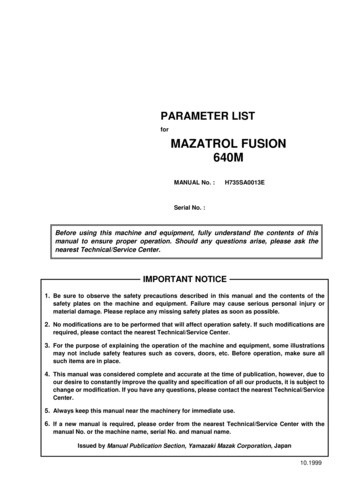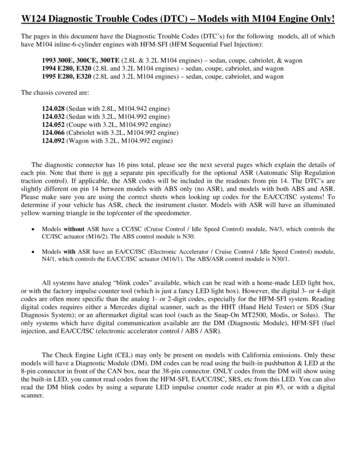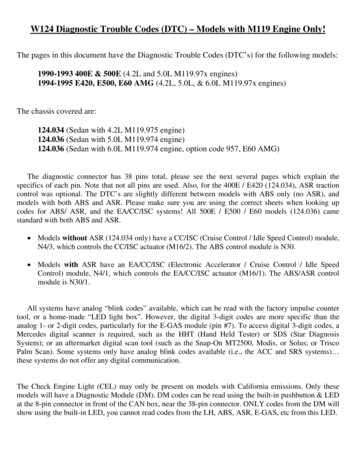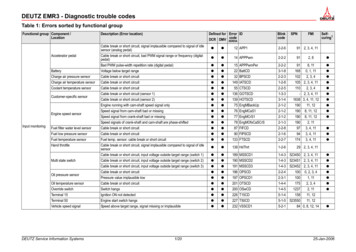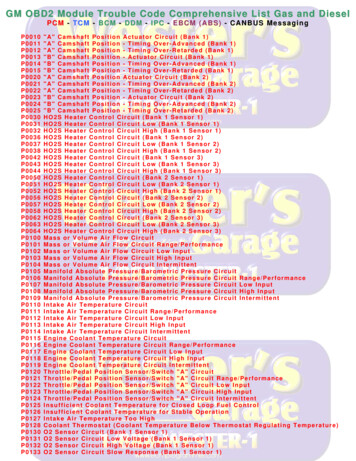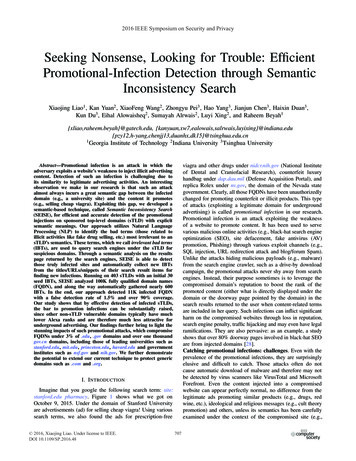
Transcription
2016 IEEE Symposium on Security and PrivacySeeking Nonsense, Looking for Trouble: EfficientPromotional-Infection Detection through SemanticInconsistency SearchXiaojing Liao1 , Kan Yuan2 , XiaoFeng Wang2 , Zhongyu Pei3 , Hao Yang3 , Jianjun Chen3 , Haixin Duan3 ,Kun Du3 , Eihal Alowaisheq2 , Sumayah Alrwais2 , Luyi Xing2 , and Raheem Beyah1{xliao,raheem.beyah}@gatech.edu, .cn1Georgia Institute of Technology 2 Indiana University 3 Tsinghua Universityviagra and other drugs under nidcr.nih.gov (National Instituteof Dental and Craniofacial Research), counterfeit luxuryhandbag under dap.dau.mil (Defense Acquisition Portal), andreplica Rolex under nv.gov, the domain of the Nevada stategovernment. Clearly, all those FQDNs have been unauthorizedlychanged for promoting counterfeit or illicit products. This typeof attacks (exploiting a legitimate domain for undergroundadvertising) is called promotional infection in our research.Promotional infection is an attack exploiting the weaknessof a website to promote content. It has been used to servevarious malicious online activities (e.g., black-hat search engineoptimization (SEO), site defacement, fake antivirus (AV)promotion, Phishing) through various exploit channels (e.g.,SQL injection, URL redirection attack and blog/forum Spam).Unlike the attacks hiding malicious payloads (e.g., malware)from the search engine crawler, such as a drive-by downloadcampaign, the promotional attacks never shy away from searchengines. Instead, their purpose sometimes is to leverage thecompromised domain’s reputation to boost the rank of thepromoted content (either what is directly displayed under thedomain or the doorway page pointed by the domain) in thesearch results returned to the user when content-related termsare included in her query. Such infections can inflict significantharm on the compromised websites through loss in reputation,search engine penalty, traffic hijacking and may even have legalramifications. They are also pervasive: as an example, a studyshows that over 80% doorway pages involved in black-hat SEOare from injected domains [28].Catching promotional infections: challenges. Even with theprevalence of the promotional infections, they are surprisinglyelusive and difficult to catch. Those attacks often do notcause automatic download of malware and therefore may notbe detected by virus scanners like VirusTotal and MicrosoftForefront. Even the content injected into a compromisedwebsite can appear perfectly normal, no difference from thelegitimate ads promoting similar products (e.g., drugs, redwine, etc.), ideological and religious messages (e.g., cult theorypromotion) and others, unless its semantics has been carefullyexamined under the context of the compromised site (e.g.,Abstract—Promotional infection is an attack in which theadversary exploits a website’s weakness to inject illicit advertisingcontent. Detection of such an infection is challenging due toits similarity to legitimate advertising activities. An interestingobservation we make in our research is that such an attackalmost always incurs a great semantic gap between the infecteddomain (e.g., a university site) and the content it promotes(e.g., selling cheap viagra). Exploiting this gap, we developed asemantic-based technique, called Semantic Inconsistency Search(SEISE), for efficient and accurate detection of the promotionalinjections on sponsored top-level domains (sTLD) with explicitsemantic meanings. Our approach utilizes Natural LanguageProcessing (NLP) to identify the bad terms (those related toillicit activities like fake drug selling, etc.) most irrelevant to ansTLD’s semantics. These terms, which we call irrelevant bad terms(IBTs), are used to query search engines under the sTLD forsuspicious domains. Through a semantic analysis on the resultspage returned by the search engines, SEISE is able to detectthose truly infected sites and automatically collect new IBTsfrom the titles/URLs/snippets of their search result items forfinding new infections. Running on 403 sTLDs with an initial 30seed IBTs, SEISE analyzed 100K fully qualified domain names(FQDN), and along the way automatically gathered nearly 600IBTs. In the end, our approach detected 11K infected FQDNwith a false detection rate of 1.5% and over 90% coverage.Our study shows that by effective detection of infected sTLDs,the bar to promotion infections can be substantially raised,since other non-sTLD vulnerable domains typically have muchlower Alexa ranks and are therefore much less attractive forunderground advertising. Our findings further bring to light thestunning impacts of such promotional attacks, which compromiseFQDNs under 3% of .edu, .gov domains and over one thousandgov.cn domains, including those of leading universities such asstanford.edu, mit.edu, princeton.edu, havard.edu and governmentinstitutes such as nsf.gov and nih.gov. We further demonstratethe potential to extend our current technique to protect genericdomains such as .com and .org.I. I NTRODUCTIONImagine that you google the following search term: site:stanford.edu pharmacy. Figure 1 shows what we got onOctober 9, 2015. Under the domain of Stanford Universityare advertisements (ad) for selling cheap viagra! Using varioussearch terms, we also found the ads for prescription-free 2016, Xiaojing2375-1207/16 31.00Liao. Under2016 IEEElicense to IEEE.DOI 10.1109/SP.2016.48707
General Service Administration, EDUCAUSE, DoD NetworkInformation Center), represents a narrow community and carriesdesignated semantics (Section III-A). Later we show that thetechnique has the potential to be extended to generic TLD(gTLD, see Section V-B).SEISE is designed to search for a set of strategically selectedirrelevant terms under an sTLD (e.g., .edu) to find out thesuspicious FQDNs (e.g., stanford.edu) associated with theterms, and then further search under the domains and inspect thesnippets of the results before flagging them as compromised.To make this approach work, a few technical issues need to beaddressed: (1) how to identify semantic inconsistency betweeninjected pages and the main content of a domain; (2) how tocontrol the false positives caused by the legitimate contentincluding the terms, e.g., a health center sites on StanfordUniversity (containing the irrelevant term “pharmacy”); (3)how to gather the search terms related to diverse promotionalcontent. For the first issue, our approach starts with a smallset of manually selected terms popular in illicit activities (e.g.,gambling, drug and adult) and runs a word embedding basedtool to calculate the semantic distance between these terms anda set of keywords extracted from the sTLD’s search content,which describe the sTLD’s semantics. Those most irrelevantare utilized for detection (Section III-B). To suppress falsepositives, our approach leverages the observation that similarpromotional content always appear on many different pagesunder a compromised domain for the purpose of improvingthe rank of the attack website pointed to by the content. As aresult, a search of the irrelevant term under the domain willyield a result page on which many highly frequent terms (suchas “no prescription”, “low price” in the promotional content)turn out to rarely occur across the generic content under thesame domain (e.g., stanford.edu). This is very different fromthe situation, for example, when a research article mentionsviagra, since the article will not be scattered across many pagesunder the site and tends to contain the terms also showingup in the generic content under the Stanford domain, such as“study”, “finding”, etc (Section III-B). Finally, using the termsextracted from the result snippets of the sites detected, SEISEfurther automatically expands the list of the search terms forfinding other attacks (Section III-C).We implemented SEISE and evaluated its efficacy in ourresearch (Section IV). Using 30 seed terms and 403 sTLDs(across 141 countries and 89 languages), our system automatically analyzed 100K FQDNs and along the way, expanded thekeyword list to 597 terms. In the end, it reported 11K infectedFQDNs, which have been confirmed to be compromised1through random sampling and manual validation. With itslow false detection rate (1.5%), SEISE also achieved over 90%detection rate. Moving beyond sTLD, we further explore thetitleURLsnippetFig. 1: Search findings of promotional injections in stanford.edu.Search engine result is organized as title, URL and snippet.selling red wine is unusual on a government’s website). Sofar, detection of the promotional infections mostly relies onthe community effort, based upon the discoveries made byhuman visitors (e.g., PhishTank [5]) or the integrity checks thata compromised website’s owner performs. Although attemptshave been made to detect such attacks automatically, e.g.,through a long term monitoring of changes in a website’sDOM structure to identify anomalies [16] or through computervision techniques to recognize a web page’s visual change [17],existing approaches are often inefficient (requiring long termmonitoring or analyzing the website’s visual effects) and lesseffective, due to the complexity of the infections, which, forexample, can introduce a redirection URL indistinguishablefrom a legitimate link or make injected content only visible tothe search engine.Semantic inconsistency search. As mentioned earlier, fundamentally, promotional infections can only be captured byanalyzing the semantic meaning of web content and thecontext in which they appear. To meet the demand for a largescale online scan, such a semantic analysis should also befully automated and highly efficient. Techniques of this type,however, have never been studied before, possibly due to theconcern that a semantic-based approach tends to be complicatedand less accurate. In this paper, we report a design that makes abig step forward on this direction, demonstrating it completelypossible to incorporate Natural Language Processing (NLP)techniques into a lightweight security analysis for efficient andaccurate detection of promotional infections. A key observationhere is that for the attacks in Figure 1, inappropriate contentshows up in the domains with specific meanings: no one expectsthat a .gov or .edu site promotes prohibited drugs, counterfeitluxury handbags, replica watches, etc. Such inconsistency canbe immediately identified and located from the itemized searchresult on a returned search result page, which includes thetitle, URL and snippet for each result (as marked out inFigure 1). This approach, which detects a compromised domain(e.g., stanford.edu) based upon the inconsistency between thedomain’s semantics and the content of its result snippet reportedby a search engine with regard to some search terms, iscalled semantic inconsistency search or simply SEISE. Ourcurrent design of SEISE focuses on sponsored top-level domain(sTLD) like .gov, .edu, .mil, etc., that has a sponsor (e.g., US1 Note that in line with the prior research [22], the term “compromise” hererefers to not only direct intrusion of a web domain, which was found tobe the most common cases in our research (80%, see Section VI), but alsoposting of illicit advertising content onto the domain through exploiting itsweak (or lack of) input sanitization: e.g., blog/forum Spam and link Spam(using exposed server-side scripts to dynamically generate promotion pagesunder the legitimate domain).708
potential extension of the technique to gTLDs such as .com(Section V-B). A preliminary design analyzes .com domainsusing their site tag labeled by SimilarSites [8], which is foundto be pretty effective: achieving a false detection rate (FDR) of9% when long keywords gathered from compromised sTLDsare used.Our findings. Looking into the promotional infections detectedby SEISE, we were surprised by what we found: for example,about 3% (175) of .gov domains and 3% (246) of .edudomains are injected; also around 2% of the 62,667 Chinesegovernment domains (.gov.cn) are contaminated with ads,defacement content, Phishing, etc. Of particular interest isa huge gambling campaign we discovered (Section V-C),which covers about 800 sTLDs and 3000 gTLDs across12 countries and regions (US, China, Taiwan, Hong Kong,Singapore and others). Among the victims are 20 US academiainstitutes such as nyu.edu, ucsd.edu, 5 government agencies likeva.gov, makinghomeaffordable.gov, together with 188 Chineseuniversities and 510 Chinese government agencies. We evenrecovered the attack toolkit used in the campaign, whichsupports automatic site vulnerability scan, shell acquisition,SEO page generation, etc. Also under California government’sdomain ca.gov, over one thousand promotion pages werefound, all pointing to the same online casino site. Anothercampaign involves 102 US universities (mit.edu, princeton.edu,stanford.edu, etc.), advertising “buy cheap essay”. The scope ofthese attacks go beyond commercial advertising: we found that12 Chinese government and university sites were vandalizedwith the content for promoting Falun Gong. Given the largenumber of compromised sites discovered, we first reportedthe most high-impact findings to related parties (particularlyuniversities and government agencies) and will continue to doso (Section VI).Further, our measurement study shows that some sTLDs suchas .edu, .edu.cn and .gov.cn are less protected than the .comdomains with similar Alexa ranks, and therefore become softtargets for promotional infections (Section V-B). By effectivelydetecting the attacks on these sTLDs, SEISE raises the bar forthe adversary, who has to resort to less guarded gTLDs, whichtypically have much lower Alexa ranks, making the attacks,SEO in particular, less effective.Contributions. The contributions of the paper are outlined asfollows: Efficient semantics-based detection of promotional infections.We developed a novel technique that exploits the semanticgap between domains (sTLDs in particular) and unauthorizedcontent they host to detect the compromised websites that serveunderground advertising. Our technique is highly effective,incurring low false positives and negatives. Also importantly,it is simple and efficient: often a compromised domain canbe detected by querying Google no more than 3 times. Thisindicates that the technique can be easily scaled, with the helpof search providers. Measurement study and new findings. We performed alarge-scale measurement study on promotional infections, thefirst of this kind. Our research brings to light several high-impact, ongoing underground promotion campaigns, affectingleading educational institutions and government agencies, andthe unique techniques the perpetrator employs. Further wedemonstrate the impacts of our innovation, which significantlyraises the bar to promotional infections and can potentially beextended to protect generic domains.Roadmap. The rest of the paper is organized as follows:Section II provides background information for our study;Section III elaborates on the design of SEISE; Section IVreports the implementation details and evaluation of ourtechnique; Section V elaborates on our measurement studyand new findings; Section VI discusses the limitations of ourcurrent design and potential future research; Section VII reviewsrelated prior research and Section VIII concludes the paper.II. BACKGROUNDIn this section, we lay out the background information ofour research, including the promotional infection, sTLD, NLPand the assumptions we made.Promotional infection. As mentioned earlier, promotion infection is caused by exploiting the weakness of a website toadvertise some content. A typical form of such an attack isblack-hat SEO, a technique that improves the rank of certaincontent on the results page by taking advantage of the waysearch engines work, regardless of the guidelines they provide.Such activities can happen on a dedicated host, for example,through stuffing the pages with the popular search terms thatmay not be related to the advertised content, for the purposeof enhancing the chance for the user to find the pages. Inother cases, the perpetrator compromises a high-rank websiteto post an ad pointing to the site hosting promoted content,in an attempt to utilize the compromised site’s reputation tomake the content more visible to the user. This can also bedone when the site does not check the content uploaded there,such as visitors’ comments, which causes its display of blog orforum Spam. Such SEO approaches, the direct compromise andthe uploading of Spam ads, are considered to be promotionalinfections. Different from the SEO on a dedicated host, theseapproaches leverage a legitimate site and also provide theirad-related keywords to the search engine crawler, to attracttargeted visitors.The promotional infection can be used for multiple goalssuch as malware distribution, phishing, blackhat SEO orpolitical agenda promotion. Black-hat SEO is often usedto advertise counterfeit or unauthorized products. The samepromotional tricks have also been played to get other maliciouscontent to the audience at which the adversary aims. Prominentexamples are Phishing websites that try to defraud the visitorsof their private information (user names, passwords, creditcard numbers, etc.) and fake AV sites that cheat the user intodownloading malware.Sponsored top-level domains. A sponsored top-level domain(sTLD) is a specialized top-level domain that has privateagencies or organizations as its sponsors that establish andenforce rules restricting the eligibility to use the domain basedon community theme concepts. For example, .aero is sponsored709
by SITA, which limits registrations to members of the airtransport industry. Compared to unsponsored top-level domain(gTLD), an sTLD typically carries designated semantics fromits sponsors. For example, as a sponsored TLD, .edu, which issponsored by EDUCAUSE, indicates that the correspondingsite is post-secondary institutions accredited by an agencyrecognized by the U.S. Department of Education. Note thatsTLDs for different countries are also associated with specificsemantic meanings as stated in ICANN, e.g., edu.cn for Chineseeducation institutions.In our research, we collected sTLDs for different countriesaccording to the 10 categories provided by ICANN [9]: .aero,.edu, .int, .jobs, .mil, .museum, .post, .gov, .travel, .xxx and thepublic suffix list maintained by the Mozilla Foundation [6].All together, we got 403 sTLDs from 141 countries.Natural language processing. The semantics informationSEISE relies on is automatically extracted from web contentusing Natural Language Processing. Technical advances in thearea has already made effective keyword identification andsentence processing a reality. Below we briefly introduce thekey NLP techniques used in our research. " ! " ! ! ! "# " " Fig. 2: Overview of the SEISE infrastructure.such as syntactically plausible terminological noun phrases.Then, the terminological candidates are further analyzed usingstatistical approaches (e.g., point-wise mutual information) todetermine important terms.Adversary model. In our research, we consider the adversarywho tries to exploit legitimate websites for promoting unauthorized content. Examples of such content include unlicensedonline pharmacies, fake AV, counterfeit, politics agenda orPhishing sites. For this purpose, the adversary could inject adsor other content into the target sites to boost the search rankof the content he promotes or use sTLD sites as redirectors tomonetize traffic. Word embedding (skip-gram model). A word embeddingW : words V n is a parameterized function mapping wordsto high-dimensional vectors (200 to 500 dimensions), e.g.,W (‘education ) (0.2, 0.4, 0.7, .), to represent the word’srelation with other words. Such a mapping can be done indifferent ways, e.g., using the continual bag-of-words modeland the skip-gram technique to analyze the context in whichthe words show up. Such a vector representation ensures thatsynonyms are given similar vectors and antonyms are mapped todissimilar vectors. Also interestingly, the vector representationsfit well with our intuition about the semantic relations betweenwords: e.g., the vectors for the words ‘queen’, ‘king’, ‘man’ and‘woman’ have the following relation: vqueen vwoman vman vking . In our research, we utilized the vectors to compare thesemantics meanings of different words, by measuring the cosinedistance between the vectors. For example, using Wikipediapages as a training set (for the context of individual words), ourapproach automatically identified the words semantically-closeto ‘casino’, such as ‘gambling’ (with a cosine distance 0.35),‘vegas’ (0.46) and ‘blackjack’ (0.48).III. SEISE: D ESIGNAs mentioned earlier, promotional infections often do notpropagate malicious payloads (e.g., malware) directly andinstead only post ads or other content that legitimate websitesmay also contain. This makes detection of such attacksextremely difficult. In our research, we look at the problemfrom a unique perspective, the inconsistency between themalicious advertising content and the semantics of the website,particularly, what is associated with different sTLDs. Morespecifically, underlying SEISE are a suite of techniques thatsearch sTLDs (.edu, .gov, etc.) using irrelevant bad terms(IBT) (the search terms unrelated to the sTLDs but heavilyinvolved in malicious activities like Spam, Phishing) to findpotentially infected FQDNs, analyze the context of the IBTsunder those FQDNs to remove false positives and leveragedetected infections to identify new search terms, automaticallyexpanding the IBT list. Below we elaborate on this design. Parts-of-speech (POS) tagging and phrase parsing. POStagging is a procedure of labeling a word in the text (corpus)as corresponding to a particular part of speech as well as itscontext (such as nouns and verbs). POS tagging accepts the textas input and outputs the words labeling with POS such as noun,verb, adjective, etc. Phrase parsing is the technique to dividesentences into phrases that logically belong together. Phraseparsing accepts texts as input and outputs a series of phrases inthe texts. The state-of-the-art POS tagging and phrase parsingtechniques can achieve over 90% accuracy [20], [32], [26]. POStagging and phrase parsing can be used in the content termextraction, i.e., determining important terms within a givenpiece of text. Specifically, after parsing phrases from the givencontent, POS tagger helps to tag the terminological candidates,A. OverviewArchitecture. Figure 2 illustrates the architecture of SEISE,which includes Semantics Finder, Inconsistency Searcher,Context Analyzer and IBT Collector. Semantics Finder takesas its input a set of sTLDs, automatically identifying thekeywords that represent their semantics. These keywords arecompared with a seed set of IBTs to find the most irrelevantterms. Such selected terms are then utilized by InconsistencySearcher to search related sTLDs for the FQDNs carryingthese terms. Under each detected FQDN, Context Analyzer710
detect other advertising targets (e.g., red wine) not included inthe initial IBT list (e.g., those for promoting illegal drugs). Thesame technique can also be applied to find out compromisedgTLDs like the .com FQDNs involved in the same campaign.further evaluates the context of discovered IBTs througha differential analysis to determine whether after removingstop words, i.e., the most common words like ‘the’ fromthe context, frequently-used terms identified there (e.g., thesearch result of site:stanford.edu pharmacy) become rare acrossthe generic content of the FQDN (e.g., the search result ofsite:stanford.edu), which indicates that the FQDN has indeedbeen compromised. Such FQDNs are reported by SEISE andtheir snippets are used by IBT Collector to extract keywords.Those with the largest semantic distance from the sTLDs areadded to the IBT list for detecting other infected FQDNs.Example. To explain how SEISE works, let us take a look atthe example at the beginning of the paper (Figure 1). For thesTLD .edu, SEISE first runs Semantics Finder to automaticallyextract keywords to profile sTLD, e.g., “education”, “UnitedStates” and “student”. In the meantime, a seed set of IBTs,including “casino”, “pharmacy” and others, are converted intovectors using the word-embedding technique. Their semanticgap with the .edu sTLD is measured by calculating the cosinedistances between individual terms (like “pharmacy”) and thesTLD keywords (such as “education”, “United States” and“student”). It turns out that the terms like “pharmacy” areamong the most irrelevant (i.e., with a large distance with.edu). It is then used to search Google under .edu, which showsthe FQDN stanford.edu hosting the content with the searchterm. Under this FQDN, SEISE again searches for “pharmacy.”The results page is presented in Figure 1. As we can see,many search result items (for different URLs) contain sametopic words, similar snippet and even URL patterns, which aretypically caused by mass injection of unauthorized advertisingmaterials. These items form the context for the IBT “pharmacy”in stanford.edu.Our approach then converts the context (the result items)found into a high-dimensional vector, with the frequency ofeach word (except those common stop words like ‘she’, ‘does’,etc.) as an element of the vector. The vector, considered to bea representative of the context, then goes through a differentialanalysis: it is compared with the vector of a reference, thesearch results page of site:stanford.edu that describes thegeneric content under the FQDN. The purpose is to find outwhether the context is compatible with the theme of the FQDN.If the distance between them is large, then we know thatthis FQDN hosts a large amount of similar text semanticallyincompatible with its theme (i.e., most of the high frequentwords in the suspicious text, such as “viagra”, rarely appearin the common content of the FQDN). Also given the factthat such text is the context for the search terms irrelevant tothe sTLD of the current FQDN but popular in promotionalinfections, we conclude that the FQDN stanford.edu is indeedcompromised.Once an infection is detected, the terms extracted fromthe context of “pharmacy” are then analyzed and those mostirrelevant to the semantics of .edu are added to the IBT listfor finding other compromised FQDNs. Examples of the termsinclude “viagra”, “cialis”, and “tadalafil”. In addition to thewords, the URL pattern of the infection is then generalized toB. Semantics-based DetectionIn this section, we present the technical details for SemanticsFinder, Inconsistency Searcher and Context Analyzer.Finding semantics for sTLDs. The first step of our approachis to automatically build a semantic profile for an sTLD. Sucha profile is represented as a set of terms, which serve as aninput to the Inconsistency Searcher for choosing right IBTs.For example, the semantic representation of the sTLD .edu.cncould be “Chinese university”, “education”, “business school”,etc. SEISE automatically identifies these terms from differentsources using a term extraction technique. Specifically, thefollowing two sources are currently utilized by our prototype: Wikipedia: the Wikipedia pages for sTLDs provide acomprehensive summary of different sTLDs. For example, https:// en.wikipedia.org/ wiki/ .mil profiles the sTLD .mil, includingits sponsor (“DoD Information System Agency”), intended use(“military entities”), registration restrictions (“tightly restrictedto eligible agencies”), etc. In our research, we ran a crawlerthat collected the wiki pages for 80 sTLDs. Search results: the search results page for an sTLD query(e.g., site:gov) lists high-profile websites under the sTLD. Asmentioned earlier, each search result includes a snippet of awebsite, which offers a concise but high-quality descriptionof the website. Since the websites under the sTLD carry thesemantic information of the sTLD, such descriptions can beused as another semantic source of the sTLD. Therefore,our approach collected the search result pages of all 403sTLDs using automatically-generated queries in the form of“site:sTLD”, such as site:edu. From each result page, top 100search results are picked up for constructing the related sTLD’ssemantic profile.From such sTLD semantics sources, the Semantics Finderruns a content term extraction tool to automatically gatherkeywords from the sources. These keywords are supposed tobest summarize the topic of each source and therefore representthe semantics of an sTLD. In our implementation, we utilizedan open-source tool topia.termextract [30] for this purpose.From each keyword extracted, our approach further calculatesits frequency, which is assigned to the keyword as its weight.All together, top 20 keywords are chosen for each sTLD as itssemantics profile.A problem is that among all 403 sTLDs, 71 of them arenon-English ones, which include Chinese, Russian, French,Arabic, etc., 89 languages altogether. Analyzing these sTLDsin their native languages is complicated, due to the challengesin processing these languages: for example, segmenting Chinesecharacters into words is known to be hard [35]. To solve thisproblem, we utilized Google Translate to convert the searchpage of an non-English sTLD query into English and thenextract their English keywords. The approach was found to711
Query — site:mysau3.arbor.edu “casino”Query — site:www.unlv.edu Portlets/ICS/bookmarkportlet/viewhandler.ashx?id 913a2a91-8cd9-491a-aaae-7d4837b93fc0","title":"O
Seeking Nonsense, Looking for Trouble: Efficient Promotional-Infection Detection through Semantic Inconsistency Search Xiaojing Liao1, Kan Yuan2, XiaoFeng Wang2, Zhongyu Pei 3, Hao Yang , Jianjun Chen 3, Haixin Duan , Kun Du3, Eihal Alowaisheq 2, Sumayah Alrwais2, Luyi Xi
